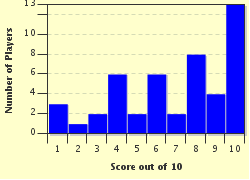Quiz Answer Key and Fun Facts
1. In a gross miscarriage of justice, Rufus Dawes is transported to Australia, charged with a murder he did not commit. Which state was he sent to 'for the term of his natural life'?
2. Richard Flanagan's 2014 Man Booker Prize winning novel, 'Narrow Road to the Deep North', tells the story of Dorigo 'Dorry' Evans. It examines how his later years are molded by his character, an illicit love affair and his experiences, especially during World War II. Captured by the Japanese, where was Dorry forced to go, where he witnessed acts of great courage, mateship and cruelty?
3. Mark Greenwood's 2003 book 'The Legend of Lasseter's Reef' tells the story of Harold Bell Lasseter and his claims of finding great riches in central Australia around the start of the 20th century. What did Lasseter ostensibly find?
4. A mixed-blood, Aboriginal man has gone missing and is suspected of multiple murders after being ostracized by both black and white communities for marrying a white woman at the start of the 20th century. Which moving and traumatic 1972 novel by Thomas Keneally tells this story which culminates in a tragic conclusion?
5. Which Australian geologist wrote 'The Home of the Blizzard', a first-hand account of the tribulations and grandeur associated with exploring Antarctica?
6. The 2010 book 'The Dig Tree', by Sarah Murgatroyd, recounts the events occurring during which famous 1861 expedition that attempted to travel from Melbourne to the north coast of Australia and back again?
7. In Joan Lindsay's 1967 story, a group of schoolgirls from Appleyard College have mysteriously disappeared in the Mount Macedon area in Victoria in 1900. What was the title of this book (and a 1975 film of the same name)?
8. Arthur Upfield wrote a series of novels over a nearly 40 year period, set in the Outback, featuring a half-white, half-Aboriginal detective. Often going under cover as 'Nat Bonnar', what was the 'true' name of this Queensland police officer who regularly explored the outback to solve crimes others couldn't?
9. What is the name of John Marsden's highly popular novel that starts with a group of teenagers finding out that almost all of their town's population has gone missing, as mysterious warplanes fly overhead?
10. One of Australia's greatest novelists, Patrick White, was awarded the Nobel Prize in Literature in 1973. Upon which missing Prussian explorer (of Australia) did White base his powerful novel 'Voss'?
Source: Author
MikeMaster99
This quiz was reviewed by FunTrivia editor
LadyCaitriona before going online.
Any errors found in FunTrivia content are routinely corrected through our feedback system.

